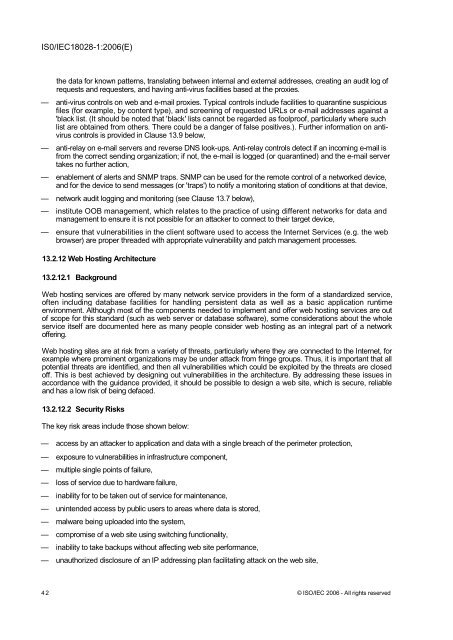INTERNATIONAL ISO/IEC STANDARD 18028-1
INTERNATIONAL ISO/IEC STANDARD 18028-1
INTERNATIONAL ISO/IEC STANDARD 18028-1
- No tags were found...
You also want an ePaper? Increase the reach of your titles
YUMPU automatically turns print PDFs into web optimized ePapers that Google loves.
IS0/<strong>IEC</strong><strong>18028</strong>-1:2006(E)the data for known patterns, translating between internal and external addresses, creating an audit log ofrequests and requesters, and having anti-virus facilities based at the proxies.— anti-virus controls on web and e-mail proxies. Typical controls include facilities to quarantine suspiciousfiles (for example, by content type), and screening of requested URLs or e-mail addresses against a'black list. (It should be noted that 'black' lists cannot be regarded as foolproof, particularly where suchlist are obtained from others. There could be a danger of false positives.). Further information on antiviruscontrols is provided in Clause 13.9 below,— anti-relay on e-mail servers and reverse DNS look-ups. Anti-relay controls detect if an incoming e-mail isfrom the correct sending organization; if not, the e-mail is logged (or quarantined) and the e-mail servertakes no further action,— enablement of alerts and SNMP traps. SNMP can be used for the remote control of a networked device,and for the device to send messages (or 'traps') to notify a monitoring station of conditions at that device,— network audit logging and monitoring (see Clause 13.7 below),— institute OOB management, which relates to the practice of using different networks for data andmanagement to ensure it is not possible for an attacker to connect to their target device,— ensure that vulnerabilities in the client software used to access the Internet Services (e.g. the webbrowser) are proper threaded with appropriate vulnerability and patch management processes.13.2.12 Web Hosting Architecture13.2.12.1 BackgroundWeb hosting services are offered by many network service providers in the form of a standardized service,often including database facilities for handling persistent data as well as a basic application runtimeenvironment. Although most of the components needed to implement and offer web hosting services are outof scope for this standard (such as web server or database software), some considerations about the wholeservice itself are documented here as many people consider web hosting as an integral part of a networkoffering.Web hosting sites are at risk from a variety of threats, particularly where they are connected to the Internet, forexample where prominent organizations may be under attack from fringe groups. Thus, it is important that allpotential threats are identified, and then all vulnerabilities which could be exploited by the threats are closedoff. This is best achieved by designing out vulnerabilities in the architecture. By addressing these issues inaccordance with the guidance provided, it should be possible to design a web site, which is secure, reliableand has a low risk of being defaced.13.2.12.2 Security RisksThe key risk areas include those shown below:— access by an attacker to application and data with a single breach of the perimeter protection,— exposure to vulnerabilities in infrastructure component,— multiple single points of failure,— loss of service due to hardware failure,— inability for to be taken out of service for maintenance,— unintended access by public users to areas where data is stored,— malware being uploaded into the system,— compromise of a web site using switching functionality,— inability to take backups without affecting web site performance,— unauthorized disclosure of an IP addressing plan facilitating attack on the web site,42 © <strong>ISO</strong>/<strong>IEC</strong> 2006 - All rights reserved
















